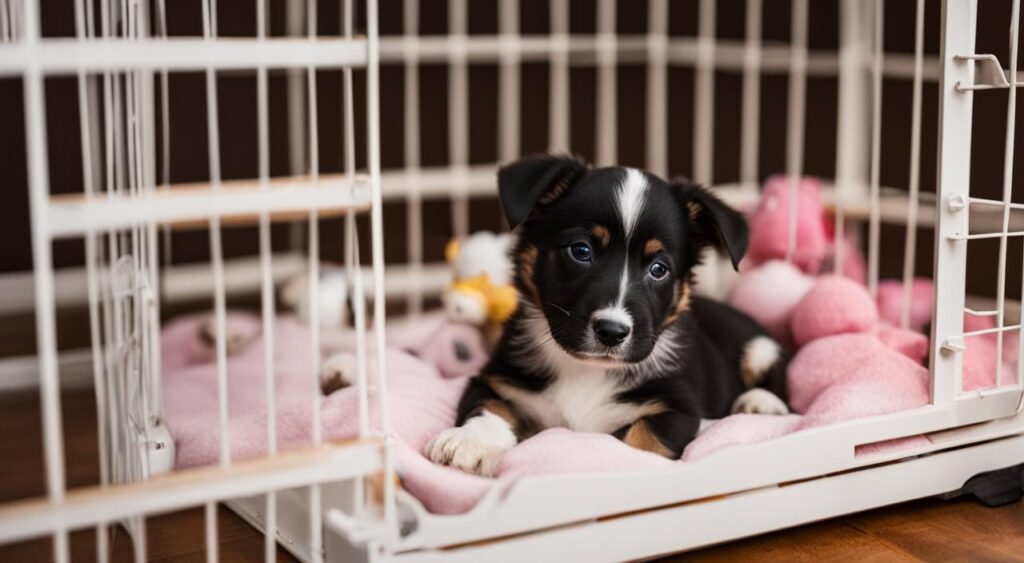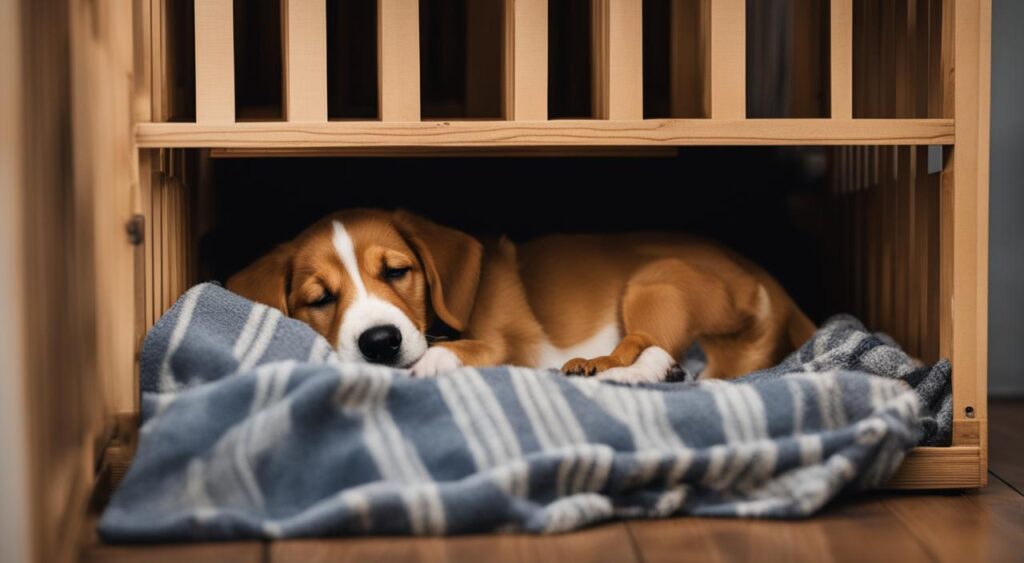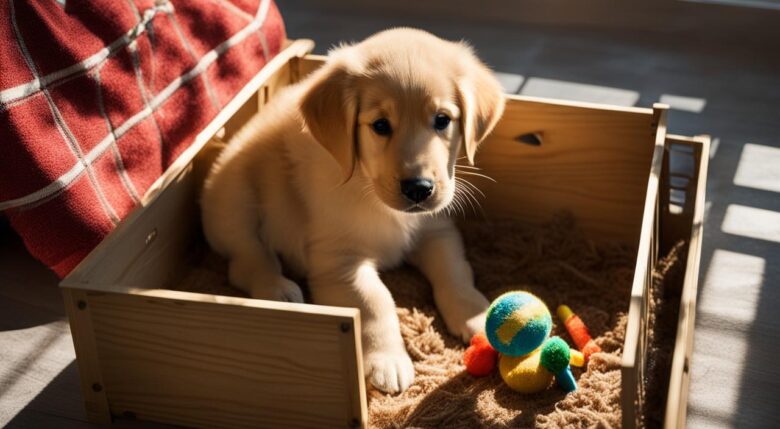Getting a new puppy can be a joyful and exciting experience. However, it can also be challenging, especially when it comes to potty training and ensuring they feel safe and secure in their new home. One effective solution to these issues is crate training. In this section, we will provide a comprehensive guide on how to crate train a puppy.
Crate training is an effective way to provide your puppy with a safe and comfortable space to rest and play. It is also an essential tool for potty training and preventing destructive behavior in your home. By establishing a routine and following some basic steps, you can successfully crate train your puppy and create a positive experience for both you and your furry friend.
Key Takeaways
- Crate training is an effective solution for potty training and preventing destructive behavior in your home.
- Establishing a routine is essential for successful crate training.
- By following basic steps and tips, you can create a positive experience for both you and your furry friend.
- It’s crucial to maintain a positive experience for your puppy once they are successfully crate trained.
- Seek professional help if you are experiencing challenges during the crate training process.
Understanding Crate Training
When it comes to crate training a new puppy, it’s essential to understand the basics before diving in. Introducing a crate to your puppy can be a positive and safe experience if done right. One of the first steps is to establish a puppy crate training schedule that works for both you and your furry friend. This schedule will play an important role in helping your puppy learn when it’s time to go inside their crate.
It’s also important to consider crate training a puppy at night. Although it may seem like a daunting task, with the right approach, you can make sure your puppy feels comfortable and secure while sleeping in their crate.
When introducing your puppy to the crate, make sure to make it a positive experience for them. Encourage them with treats and toys, but also don’t force them to go inside. Instead, let them explore the crate at their own pace. Doing this can help them feel more comfortable and relaxed when inside the crate.

Creating a comfortable and inviting space inside the crate can also go a long way. Adding soft bedding and toys can make it a more enjoyable experience for your puppy when spending time inside.
To ensure successful crate training, remember to be patient and consistent. Don’t use the crate as a form of punishment, and make sure your puppy is always comfortable and happy when inside. Remember that every puppy is different, so what works for one may not work for another. Always pay attention to your puppy’s behavior and adjust accordingly.
Crate Training Techniques
When it comes to crate training your puppy, there are different techniques to consider depending on your specific goals. Here we explore some of the most common:
Managing Crate Training While at Work
If you work outside the home and are concerned about leaving your puppy alone during the day, crate training can provide a reliable solution. To successfully crate train your puppy while at work:
- Choose the right size crate, ideally one that provides enough space for your puppy to stand up, turn around, and lie down comfortably.
- Introduce your puppy to the crate gradually, offering positive reinforcement such as treats and praise each time they enter the crate.
- Create a consistent routine around crate time by setting a regular schedule for feeding, potty breaks, and playtime.
- Consider using a puzzle toy or treat dispenser to keep your puppy stimulated and entertained while in the crate.
By following these steps, you can help your puppy view the crate as a safe and comfortable space even while you’re away.
Using the Crate for Potty Training
Crate training can also be an effective technique for potty training your puppy. To use the crate for this purpose:
- Choose a crate that is appropriately sized for your puppy to promote good habits and prevent accidents.
- Create a consistent routine around crate time, taking your puppy outside for potty breaks before and after crate time.
- Use positive reinforcement such as treats and praise each time your puppy successfully goes potty outside.
- Gradually increase the time your puppy spends in the crate between potty breaks as they develop good habits.
With patience and consistency, using the crate for potty training can help your puppy learn good habits and avoid accidents in the house.

In the next section, we’ll discuss strategies for overcoming common challenges that can arise during the crate training process.
Dealing with Challenges
While crate training can be a valuable tool for puppy owners, it is not without its challenges. Two common obstacles during the crate training process include dealing with a stubborn puppy and addressing separation anxiety.
When it comes to crate training a stubborn puppy, patience is key. It’s important to start slowly and use positive reinforcement to encourage your puppy to enter the crate willingly. Gradually increase the amount of time your puppy stays in the crate, and always reward good behavior.
In the case of separation anxiety, crate training can help your puppy feel more secure when you are not home. Start by introducing the crate as a safe and comfortable space, and gradually increase the amount of time your puppy spends in it while you are away. You can also leave a familiar scent or toy in the crate to provide additional comfort.
Remember, every puppy is unique, and crate training may take longer for some than others. Don’t get discouraged if your puppy struggles with the process, and always seek professional help if needed.
Maintaining a Positive Crate Training Experience
Now that your puppy is successfully crate trained, it’s important to continue providing a positive experience for them. Here are some tips to help maintain a safe and comfortable space:
- Keep the crate accessible: Continue leaving the crate open and accessible with the door open. This allows your puppy to enter and exit as they please, reinforcing that the crate is a safe and comfortable space.
- Provide comfort items: Place your puppy’s favorite toys and a cozy blanket inside the crate to make it a welcoming environment. Remember to avoid any items that may pose a choking or ingestion hazard.
- Stick to a routine: Continue following a consistent schedule for feeding, exercise, and potty breaks to minimize stress and anxiety for your pup.
- Avoid using the crate for punishment: Never use the crate as a form of punishment to avoid creating negative associations with the space.
By following these tips, you can ensure that your puppy continues to view their crate as a safe and comfortable sanctuary.
Conclusion
Crate training is an essential skill that will benefit both you and your puppy. A well-trained puppy will be comfortable in their crate and view it as a safe space to retreat to when needed.
By following the steps and tips outlined in this guide, you can successfully crate train your puppy. Remember to be patient and consistent throughout the training process. Celebrate every small victory and take note of any setbacks or challenges that arise.
As your puppy grows and becomes accustomed to their crate, you may need to make adjustments to their schedule or training techniques. Pay attention to their behavior and make changes as necessary.
Finally, maintaining a positive experience for your puppy is crucial. Continue to offer rewards and praise when they use their crate successfully, and avoid using the crate as a form of punishment. By doing so, you will ensure that your puppy continues to view their crate as a safe, comfortable, and positive space.
FAQ
How do I crate train a puppy?
Crate training a puppy involves gradually introducing them to the crate, making it a positive and comfortable space for them. Start by leaving the crate door open and placing enticing treats or toys inside to encourage your puppy to explore. Gradually increase the amount of time your puppy spends in the crate, rewarding them for good behavior. Remember to be patient and consistent throughout the process.
What is the purpose of crate training a puppy?
Crate training provides numerous benefits for both you and your puppy. It helps with potty training, teaches your puppy to be calm and settled, and provides them with a safe space when you’re not around. Additionally, it can prevent destructive behaviors and separation anxiety.
How long should I crate train my puppy each day?
The duration of crate training sessions depends on your puppy’s age and bladder control. Generally, puppies should not be crated for longer than their age in months plus one hour. For example, a 3-month-old puppy should not be crated for more than 4 hours at a time. It’s important to gradually increase crate time as your puppy grows and develops better bladder control.
Can I crate train my puppy at night?
Yes, crate training at night is beneficial for both you and your puppy. It helps establish a routine and teaches your puppy to sleep through the night without accidents or disturbances. Ensure the crate is comfortable and, if needed, place it near your bed so your puppy feels reassured by your presence.
How can I prevent my puppy from whining or barking in the crate?
Whining or barking in the crate can be a sign of anxiety or discomfort. To address this, make sure your puppy’s crate is placed in a quiet and peaceful area of your home. Additionally, provide them with interactive toys or puzzle feeders to keep them occupied and distract from any anxiety. Avoid letting your puppy out of the crate when they are making noise, as this may reinforce the behavior.
How do I crate train a puppy while I’m at work?
Crate training a puppy while you’re at work requires careful planning and gradual introduction. Start by leaving your puppy in the crate for short periods while you’re at home, gradually increasing the duration. Ensure you provide mental stimulation and exercise before crating them to prevent boredom or excess energy. Consider hiring a dog walker or asking a trusted friend or family member to let your puppy out for bathroom breaks and exercise during the day.
My puppy is stubborn and resists crate training. What should I do?
If your puppy is stubborn and resistant to crate training, it’s important to remain patient and consistent. Avoid forcing your puppy into the crate or using punishment as this can create negative associations. Instead, use positive reinforcement techniques, such as treats and praise, to encourage your puppy to enter the crate willingly. Make the crate inviting with comfortable bedding and toys, and gradually increase their exposure to the crate over time.
My puppy has separation anxiety. Can crate training help?
Crate training can be beneficial for puppies with separation anxiety. The crate provides a secure and enclosed environment that can help alleviate anxiety. However, it’s important to work with a professional dog trainer or behaviorist to develop a comprehensive plan for addressing separation anxiety. They can guide you on crate training techniques that are specific to your puppy’s needs.




